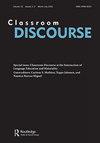Jostling Isaac: dynamic configurations of bodies and objects during a language problem solving event
IF 1.6
Q2 EDUCATION & EDUCATIONAL RESEARCH
引用次数: 4
Abstract
ABSTRACT This article, a case study of a single instance of collaborative translation in the classroom, explores the role of material mediation and embodied activity in the linguistic problem solving work of emergent multilinguals. We describe one teacher’s lesson with a small group of Spanish speaking students in her 7th grade ESL classroom. Collaborative translation is an approach that leverages the translation process (defining, translating, reading, revising, and discussing) to engage students in close readings of the text as they draw on their metalinguistic knowledge to promote deeper comprehension. Using multimodal interaction analysis methods, this paper investigates what we refer to as language problem solving events (LPSEs), a connected series of interactions around a word or phrase whose translation is a subject of negotiation. Findings describe how the material arrangement of the activity gave all participants opportunity to watch and comment on the choices being made by the scribe, so the written translation came to mediate the activity not only as a product of collective effort but also as a co-participant in the evolving interaction. The orchestrated configuration of materials fostered collective activity, but the particular affordances of the material inscription simultaneously transformed linguistic choices into objects that re-mediated subsequent action.碰撞艾萨克:在语言问题解决事件中身体和对象的动态配置
摘要本文以课堂协作翻译为例,探讨了材料中介和具身活动在突发性多语者语言问题解决工作中的作用。我们描述了一位老师在她七年级的ESL课堂上给一小群说西班牙语的学生上的课。协作翻译是一种利用翻译过程(定义、翻译、阅读、修改和讨论)让学生在深入阅读文本的同时,利用他们的元语言知识来促进更深层次的理解的方法。本文采用多模态交互分析方法,研究了我们所说的语言问题解决事件(lpse),即围绕一个词或短语的一系列相互关联的交互,而这个词或短语的翻译是协商的主题。研究结果描述了活动的材料安排如何使所有参与者都有机会观看和评论抄写员所做的选择,因此书面翻译不仅作为集体努力的产物,而且作为不断发展的互动的共同参与者来调解活动。精心安排的材料结构促进了集体活动,但材料铭文的特殊启示同时将语言选择转化为重新调解后续行动的对象。
本文章由计算机程序翻译,如有差异,请以英文原文为准。
求助全文
约1分钟内获得全文
求助全文

 求助内容:
求助内容: 应助结果提醒方式:
应助结果提醒方式:


